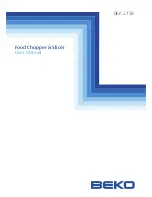SYNCHRONOUS SERIAL INTERFACE (SSI)
MOTOROLA
PORT C
6 - 145
To summarize, the network mode receiver receives every time slot data word unless the
receiver is disabled. An interrupt can occur after the reception of each data word, or the
programmer can poll RDF. The DSP program response can be
1. Read RX and use the data
2. Read RX and ignore the data
3. Do nothing – the receiver overrun exception will occur at the end of the current
time slot
4. Toggle RE to disable the receiver until the next frame, and read RX to clear RDF
Figure 6-79 is essentially the same program shown in Figure 6-74 except that this pro-
gram uses the network mode to receive only right-channel data. In the “Initialize SSI Port”
section of the program, two words per frame are selected using the DC bits in the CRA,
and the network mode is selected by setting MOD to one in the CRB. If the program in
Figure 6-78 is used to transmit to the program in Figure 6-79, the correct data will appear
in the data buffer for the right channel, but the buffer for the left channel will probably con-
tain $000000 or $FFFFFF, depending on whether the transmitter output was high or low
when TSR was written and whether the output was three-stated.
6.4.7.4
On-Demand Mode Examples
A divide ratio of one (DC=00000) in the network mode is defined as the on-demand mode
of the SSI because it is the only data-driven mode of the SSI – i.e., data is transferred
whenever data is present (see Figure 6-80 and Figure 6-81). STD and SCK from DSP1
are connected to DSP2 – SRD and SC0, respectively. SC0 is used as an input clock pin
in this application. Receive data and receive data clock are separate from the transmit sig-
nals. On-demand data transfers are nonperiodic, and no time slots are defined. When
there is a clock in the gated clock mode, data is transferred. Although they are not neces-
sarily needed, frame sync and flags are generated when data is transferred. Transmitter
underruns (TUE) are impossible in this mode and are therefore disabled. In the on-de-
mand transmit mode, two additional SSI clock cycles are automatically inserted between
each data word transmitted. This procedure guarantees that frame sync will be low be-
tween every transmitted data word or that the clock will not be continuous between two
consecutive words in the gated clock mode. The on-demand mode is similar to the SCI
shift register mode with SSFTD equals one and SCKP equals one. The receiver should
be configured to receive the bit clock and, if continuous clock is used, to receive an exter-
nal frame sync. Therefore, for all full-duplex communication in on-demand mode, the
asynchronous mode should be used. The on-demand mode is SPI compatible.
F
re
e
sc
a
le
S
e
m
ic
o
n
d
u
c
to
r,
I
Freescale Semiconductor, Inc.
For More Information On This Product,
Go to: www.freescale.com
n
c
.
..


















